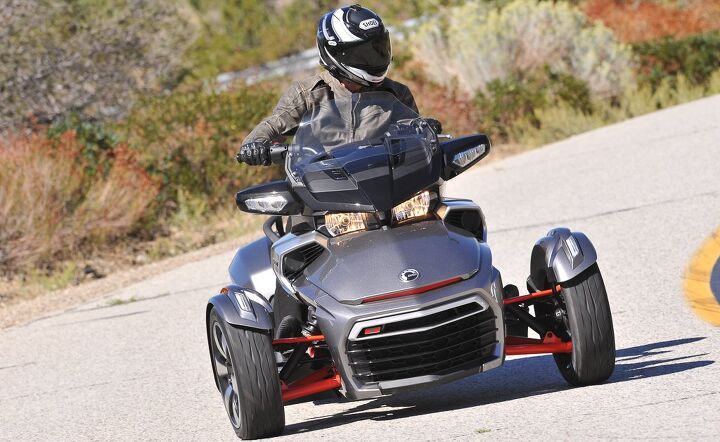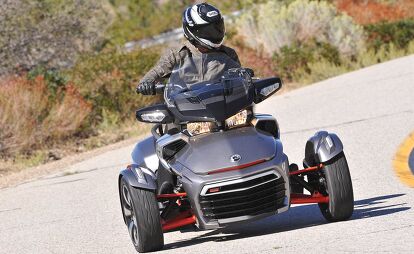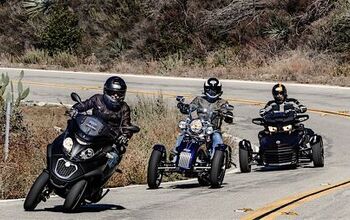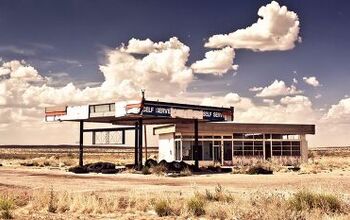2016 Can-Am Spyder F3-T First Ride Review

An F3 with baggage - the good kind
When Can-Am introduced the Spyder F3 last year, the company knew that some potential customers had requested a more cruiser-ish riding position from their three-wheeler, but I’d be willing to bet that they had no idea how many sales the change would drive. After less than one year, the F3 accounts for almost 20% of Spyder sales. Then came the owner surveys that notched the overall satisfaction level at a whopping 93%! I can only guess that the product planners were patting themselves on the back for creating the F3 as a platform and not merely a model in Spyder’s inventory since the biggest requests from F3 owners and prospective owners were more wind protection and storage from the naked roadster. (Yes, we know there was the F3-S, which is really just an optional F3 trim package. We also know Can-Am calls the Spyder a cruiser, but the roadster title feels more appropriate.)
2016 Can-Am Spyder F3-T
| Engine | 18.0/20 |
| Suspension/Handling | 12.5/15 |
| Transmission/Clutch | 7.5/10 |
| Brakes | 9.5/10 |
| Instruments/Controls | 4.5/5 |
| Ergonomics/Comfort | 9.5/10 |
| Appearance/Quality | 9.0/10 |
| Desirability | 7.5/10 |
| Value | 8.0/10 |
| Overall Score | 86/100 |
What turned the F3 from a model into a Spyder line of three-wheelers was the announcement on September 18th that the F3 had some new siblings: the F3-T and the F3 Limited. While the T and the Limited are mechanically the same as the F3, the additional comfort and convenience features make the new models feel like different vehicles. For what makes the F3 different from previous Spyders, bop on over to Tom Roderick’s first ride review from last year. (Executive summary: The new, feet-forward riding position gives the rider more leverage for sporty riding, and the electronic nanny intervenes in a less buzz-killing fashion, allowing us to spend more time in our happy place.) Here, I’m going to focus on what’s new on the T and, by extension, the Limited.
The most noticeable additions to the F3-T are the windshield and rear bags. Where the F3 only had the headlight nacelle to take the wind pressure off the rider’s chest, the F3-T gets an honest-to-goodness windshield in the front and integrated, locking bags out back. Looking in front of the handlebar, the change is more than just slapping on a windshield. The entire instrument cluster has grown to the point that it looks like a frame-mounted fairing on a motorcycle. Then the swoopy windscreen is mounted to the top of the console.
New For 2016: Spyder F3-T And F3 Limited Baggers
The F3-T’s designers managed to create a pocket of air in the cockpit that lessens the pressure on the upper body while still allowing enough air-flow to keep the rider cool in hot weather. A ride through the high desert north of Los Angeles on a day in the upper 80s proved that. Additionally, there was absolutely no buffeting at any speed for my 5-foot 11-inch frame. In fact, the bulk of the wind blast was directed over my head. Credit the laminar air flow created by the cutouts in the lower portions of the windshield for that. For riders who prefer shorter or taller screens, Can-Am’s accessory department has those ready.
The instrument cluster includes the color screen from the Spyder RT. F3-T owners have the option of buying a factory stereo system that includes a USB port in the glove box for charging and communicating with your device. The screen allows riders to access the multiple trip meters and other data screens via controls conveniently located on the left grip.
2011 Can-Am Spyder RT Limited Review
The second major change is the stylish hard bags. Since they are integral to the design of the rear section of the Spyder, they are not removable. (You’ll want to buy the accessory bag liners to carry your gear to your hotel room.) What you get with that permanent attachment are good-looking and highly visible brake lights and turn signals that qualify the F3-T for world markets without modifications. The bags also bump the F3-T’s storage capacity to over 21 gallons spread out over the saddlebags, the forward trunk, and the glove box behind the windshield. This measures out to a little more than half of the available volume for Can-Am’s dedicated tourer the Spyder RT.
The saddlebags are not capacious enough to hold a full-face helmet, but one does fit in the front trunk. The saddlebags are deeper than they are tall which allowed me to carry my MacBook Air inside a knapsack without issue. The bags also feature a clever removable tray that will keep items from rolling out of a bag when it’s opened. When a little extra room is required, the tray is easily removed. The bags are keyed to the ignition key and can be left unlocked for easy access on the road. You do, however, need to make sure the bags are securely closed, or they will flop open at speed.
To deal with the additional loads of touring, the F3-T retains its 5.2 in. of travel but gains an air-adjustable rear shock. Under the pillion, an air valve and a handy chart listing air pressures and associated carrying weights recommend what pressure to run. No pump is included, however. Running with 30 psi for about a 200 lb load kept the F3-T’s chassis level with me on board. Over freeway expansion joints and some pretty rough pavement, the single rear suspender kept all but the harshest bumps from disturbing my delicate hind parts. The double A-arms in the front gained new shocks of the SACHS Big-Bore variety with 6.9 in. of travel.
The beefier road-going suspension allows the heavier Spyder to deliver the same quality handling that the F3 had, last year, which means that the F3-T will allow more spirited riding than its non-F3 progenitors permitted. Try to corner too quickly, and the VSS (Vehicle Stability System) initially applies some brake pressure to the outside front wheel. Keep pushing to the point that the bike begins to understeer, and the VSS brakes more and cuts the power delivery until traction is regained and the cornering forces are reduced.
Can-Am Spyder F3-T
+ Highs
- Great wind protection
- Air-adjustable rear suspension
- Convenient storage
– Sighs
- VSS still (necessarily) limits fun
- Stiff clutch pull
- Harder to ride on a winding road than a motorcycle
The F3-T I rode was equipped with the SM6 manual transmission on the 1330cc Total ACE Triple, and with the exception of an excessively hard lever pull, the clutch and transmission were a pleasure to use, offering clean shifts on a relatively short throw with consistent clutch engagement. The engine puts out a claimed 96 lb-ft at 5,000 rpm and 115 hp. Can-Am also states that the F3-T is capable of 252 miles per tank, but all of these figures will have to be verified in our upcoming review of the Spyder F3 Limited Special Edition in a couple weeks. Until then, let’s suffice to say that the Triple’s exhaust note provides a pleasant background to the mechanical and intake noise of the engine. The performance is snappy with more than enough power to spin the rear wheel off the line. When considering the close to 1,000 lb. wet weight of the F3-T, ample acceleration was never more than a downshift or two away.
The Spyder F3-T will be available in two engine configurations, the aforementioned SM6 and the semi-automatic SE6. Color options are: Pearl White, Steel Black Metallic, Pure Magnesium Metallic (with Can-Am Red frame), and Intense Red Pearl. MSRP for the F3-T is $22,999. The Spyder F3-T is available for pre-order now for January 2016 delivery.
2016 Spyder F3-T Specifications | |
| MSRP | $22,999 |
| Engine Type | 1330cc liquid-cooled Rotax ACE Triple |
| Bore and Stroke | 84.0 x 80.0 mm |
| Fuel System | EFI |
| Ignition | Digital |
| Horsepower | 115 hp @ 7250 rpm (claimed) |
| Torque | 96 lb-ft @ 5000 rpm (claimed) |
| Transmission | 6-speed manual, or semi-automatic |
| Final Drive | Belt |
| Front Suspension | Double A-arm, SACHS Big-Bore shock absorbers 6.9 inches of travel |
| Rear Suspension | SACHS shock absorber with air-adjustable preload 5.2 inches of travel |
| Front Brake | 2 x 270 mm discs with radially mounted Brembo monobloc calipers |
| Rear Brake | 270 mm disc with radially mounted Brembo caliper |
| Front Tire | 165/55-15 |
| Rear Tire | 225/50-15 |
| Wheelbase | 67.3 inches |
| Seat Height | 26.6 inches |
| Claimed Dry Weight | 948 lb. |
| Fuel Capacity | 7.1 gal. |
| Available Colors | Pearl White, Steel Black Metallic, Pure Magnesium Metallic (with Can-Am Red frame), and Intense Red Pearl |
| Warranty | Two year limited including roadside assistance |

Like most of the best happenings in his life, Evans stumbled into his motojournalism career. While on his way to a planned life in academia, he applied for a job at a motorcycle magazine, thinking he’d get the opportunity to write some freelance articles. Instead, he was offered a full-time job in which he discovered he could actually get paid to ride other people’s motorcycles – and he’s never looked back. Over the 25 years he’s been in the motorcycle industry, Evans has written two books, 101 Sportbike Performance Projects and How to Modify Your Metric Cruiser, and has ridden just about every production motorcycle manufactured. Evans has a deep love of motorcycles and believes they are a force for good in the world.
More by Evans Brasfield





































Comments
Join the conversation
Nice. Is that a Falstaff jacket in the photo's? I am waiting for some cooler weather so I can don mine. John Burns' review when with CW got me interested in the retro cool.
You forgot the hand numbing vibration between 65-73 mph